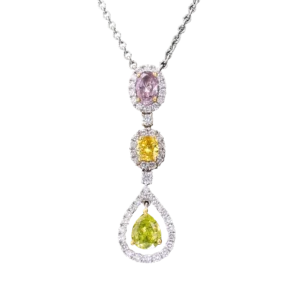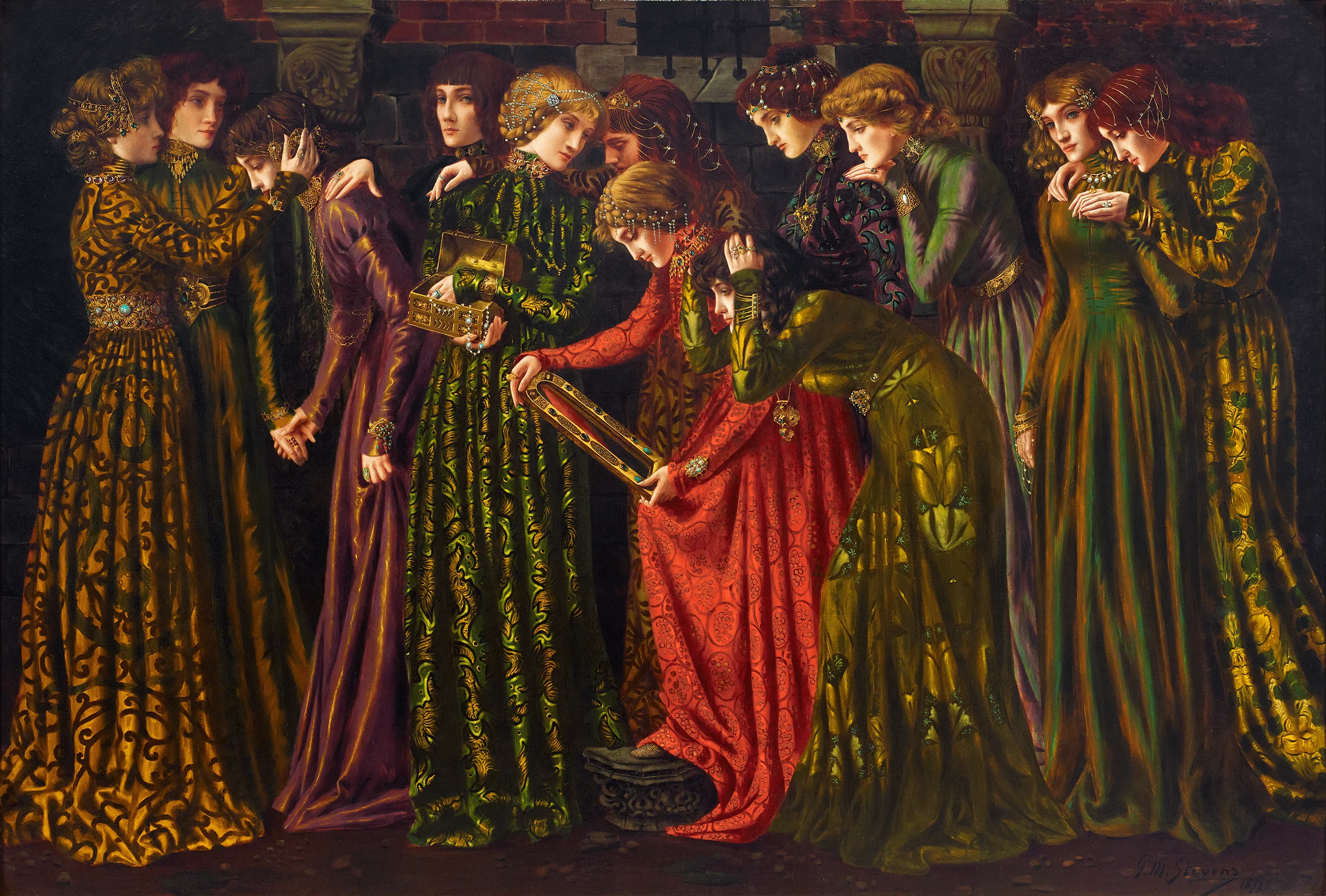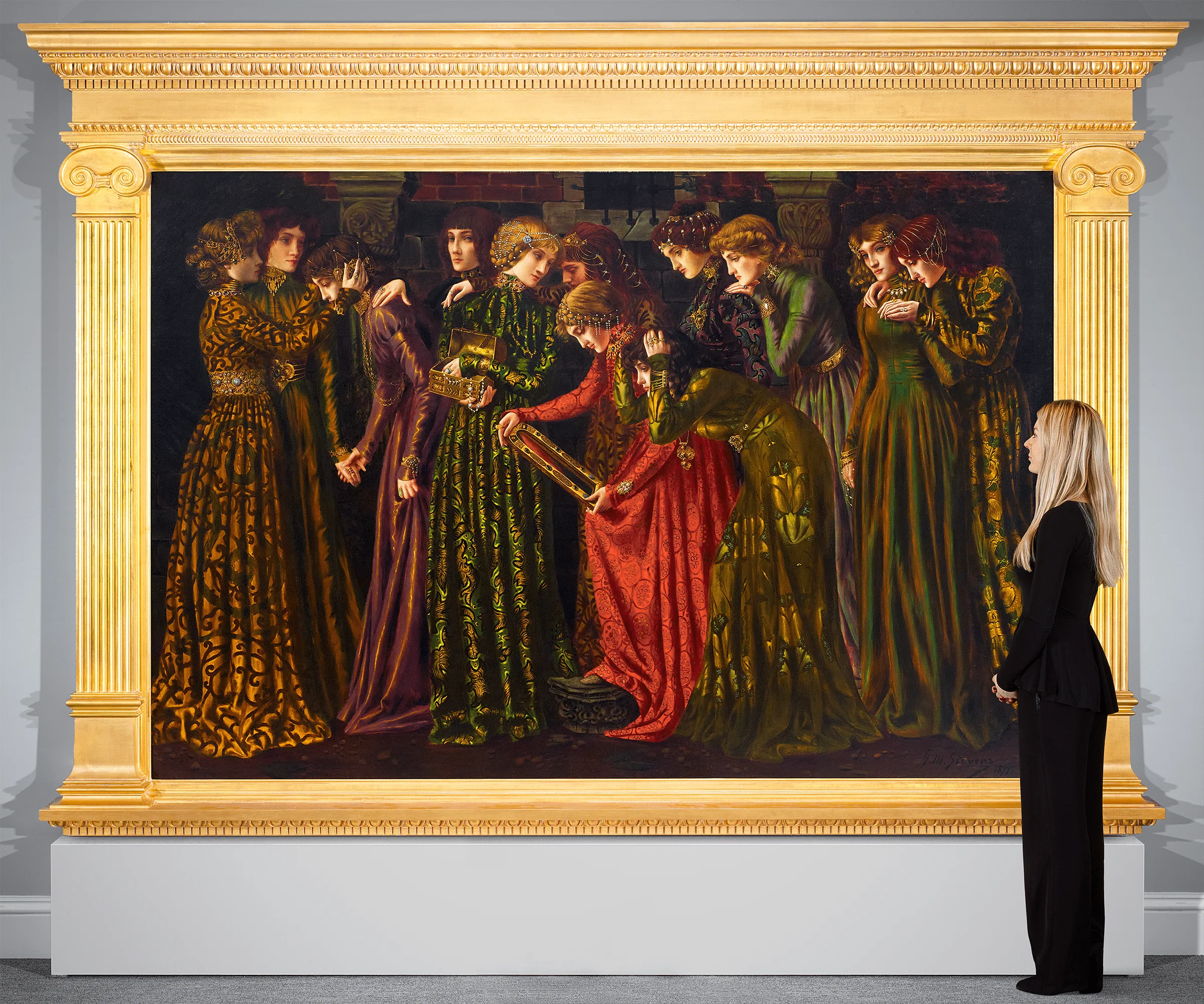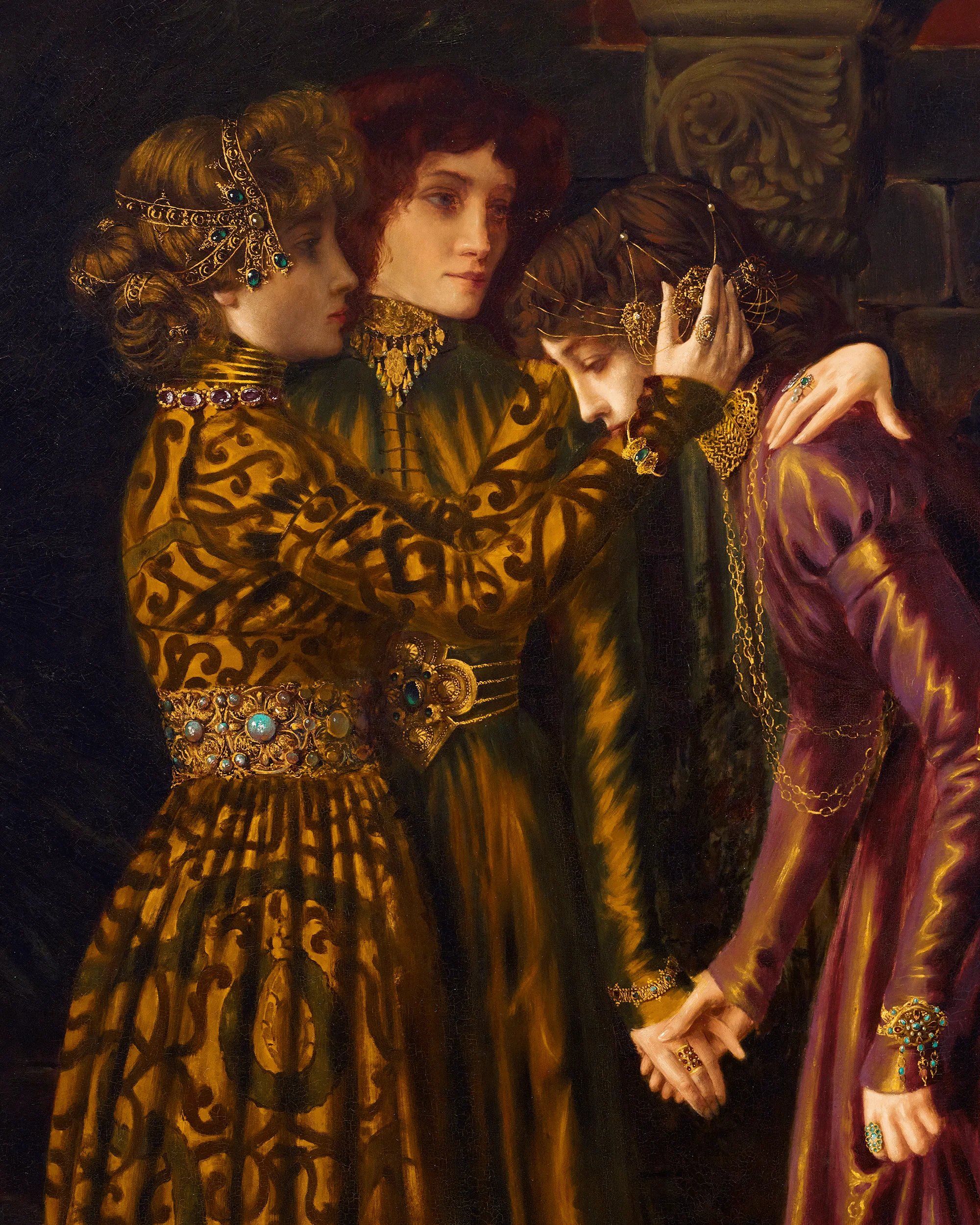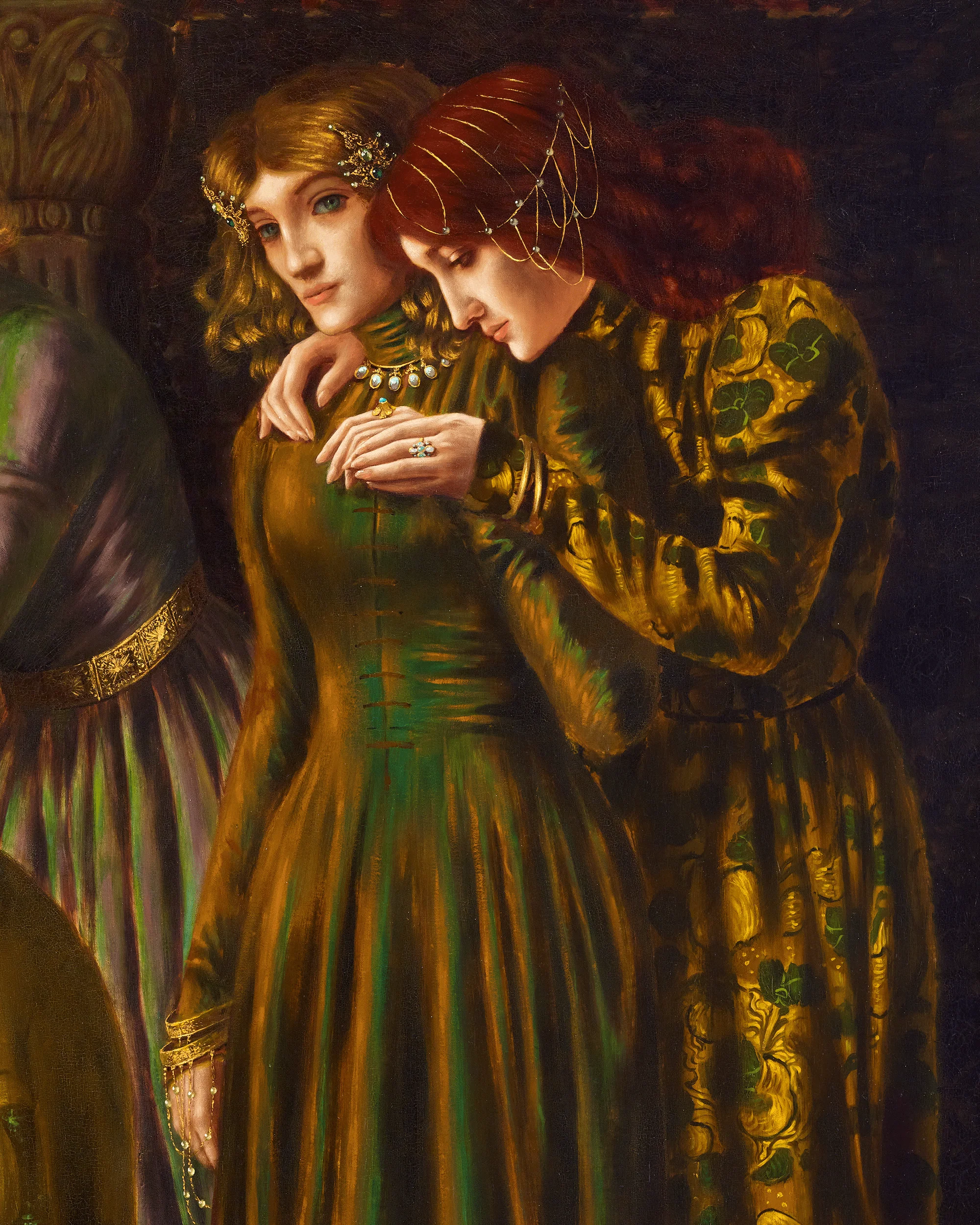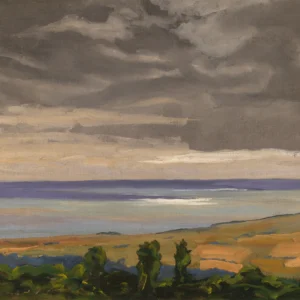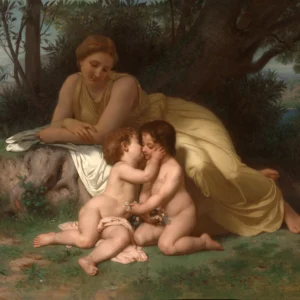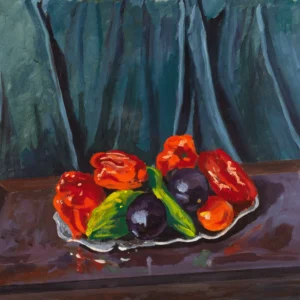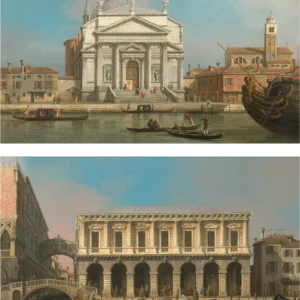Description
- This incredible Pre-Raphaelite painting was created by Belgian artist Gustave-Max Stevens
- It depicts a scene from the Grimm Brothers’ fairy tale, The Twelve Dancing Princesses
- The composition’s colossal size, rich coloring and myriad details enhance the drama of its subject
- Undoubtedly the artist’s masterpiece, it was exhibit extensively, including at the Paris Salon
Gustave-Max Stevens
1871-1946 | Belgian
The Twelve Princesses
Oil on canvas
Signed and dated “G.M. Stevens / 1899” (lower right)
The greatest triumph of the artist’s career, this extraordinary and monumental oil on canvas by Gustave-Max Stevens perfectly represents the highly detailed compositions and richly hued palettes championed by the Pre-Raphaelite Brotherhood. The composition’s larger-than-life-size, brilliant coloring and myriad details enhance the drama of its subject, the Brothers Grimm fairy tale, “The Twelve Princesses.” The artist exhibited this work extensively, including at the 1901 Paris Salon, testifying to both the artist’s regard for the work and its exceptional quality.
Monumental in subject, style and size, it is clear that the artist himself knew that The Twelve Princesses was his masterpiece, and he took every opportunity to show it publicly. It was first shown shortly after its creation at an exhibition of the artist’s work at the Cercle Artistique et Littéraire in Brussels in 1899 and then at the Salon d’Art Idéaliste in Brussels. It was then accepted into the prestigious Paris Salon of 1901, the annual exhibition where artists showcased only the very best examples of their work. The artist also exhibited it with Sächsischer Kunstverein (Saxon Art Association) in Dresden in 1900, the Antwerp Triennial Salon of 1901 and the Salon des Beaux-Arts d’Ostende of 1907. Additionally, Stevens kept The Twelve Princesses in his own personal collection for the entirety of his life, and it descended within his family — a testimony to the artist’s particular attachment to this work.
The fairy tale “The Twelve Princesses,” also called “The Shoes That Were Danced to Pieces”, tells the story of twelve sisters who are kept locked up in their bedroom every night by their father, the king. Despite this, the king finds his daughters’ shoes “danced to pieces” every morning when he releases them. He presents a challenge to his kingdom: “Whoever could discover where they went dancing each night could choose one of them for his wife and become king after his death.” After many before him fail, a man accepts the challenge and, with the help of an invisibility cloak, discovers the sisters travel to a magical underground realm where they attend a lavish ball every evening.
Stevens chooses to depict the moment of the sisters’ escape. They adorn themselves in their finest gowns and jewels, with each princess dressed more extravagantly than the last. His approach to the painting is meticulous yet romantic, and the entire composition is a feast for the senses. The long, graceful silhouettes of the princesses occupy the entirety of the colossal canvas, and the artist revels in a painstaking depiction of detail for each and every figure. Strongly-patterned, iridescent fabrics combine with lush jewel tones to create a highly expressive aesthetic that brings a sense of realism to the mythical narrative.
Stevens captures the princesses with the precise detail and symbolism that were tenets of the Pre-Raphaelite Brotherhood. They are shown standing before a window barred with iron, emphasizing the wonder of their nightly escape. The central figure gazes into a mirror, serving not as a symbol of vanity, but rather representing the ephemeral, alternate world they are about to enter. The mirror holds their secret and points beyond exterior appearances. Only two of the sisters look out at the viewer, the oldest and the youngest, who have the most significant roles in the story. The eldest, dressed the most austerely and almost hidden behind her sisters, wears a knowing look of secrecy and mystery, while the youngest looks at us apprehensively, foreshadowing their eventual exposure. Combining thoughtful detail, symbolism and aestheticism, this work showcases the enigmatic, dreamlike style of painting for which the Pre-Raphelites were renowned.
Apart from the fact that it is an exceptional example of a Pre-Raphaelite painting, it is also exemplary of the 19th-century interest in legends and fairy tales; the story of the dancing princesses would have been a well-known tale in affluent households of the age. These tales were popularized by Andrew Lang’s Fairy Book series, a collection of 12 volumes that was hugely successful. “The Twelve Dancing Princesses” was the first story printed in the Red Fairy Book edition of the series in 1890 — an edition the artist would have certainly been familiar with.
Born in Saint-Gilles, Belgium, just outside of Brussels, in 1871, Stevens began his artistic studies at the Académie Royale des Beaux-Arts in Brussels in 1886 under the instruction of Jean-François Portaels. He then studied with Fernand Cormon and Louis-Joseph-Raphaël Collin at the École des Beaux-Arts in Paris. He then returned to Brussels, a city that at the time was a major center for artistic innovation. There, he co-founded and led Le Sillon in 1893, an artistic movement that sought a different approach to painting from the Neo-Impressionists and instead espoused a philosophy of decorative realism and luminous coloring.
The great Pre-Raphaelite Edward Burne-Jones was a supporter and honorary member of Le Sillon, and the group hosted an exhibition of the master’s works in 1895. Stevens, who was already an admirer of Burne-Jones, was heavily involved in the planning of this exhibition and must have taken immense inspiration from his aesthetic approach. He completed The Twelve Princesses only a few years after the Burne-Jones show, embracing the Pre-Raphaelite ideals of truth to nature, complexity of composition and brilliance of color. He also won a coveted bronze medal at the Paris Exposition Universelle of 1900 for Annunciation, another painting with strong Pre-Raphaelite connections.
Today, his works reside in the National Gallery of Canada (Ottowa), Minneapolis Institute of Art, Musées royaux des Beaux-Arts de Belgique (Brussels) and the British Museum (London), but none surpass the current painting. Staggering in size, magnificent in palette, exceptional in technique, and fascinating in subject, The Twelve Princesses represents the very best from the artist.
See auction comparables and market data
Dated 1899
Canvas: 76 1/8″ high x 114″ wide (193.36 x 289.56 cm)
Frame: 100 1/4″ high x 138 5/8″ wide (254.64 x 352.11 cm)
Exhibited:
Exhibition Gustave-Max Stevens, Cercle Artistique et Littéraire, Brussels, 1899
Salon d’Art Idéaliste, Brussels
Paris Salon, 1901, number 846, p.27 (illustrated under the title “Filles de Rois”)
Sächsischer Kunstverein, Dresden, 1900, number 1864
Triennial Salon, Antwerp, 1901, number 46
Salon des Beaux-Arts d’Ostende, 1907
Provenance:
Collection of the artist, Brussels
Thence by descent
Private collection, Paris
M.S. Rau, New Orleans

